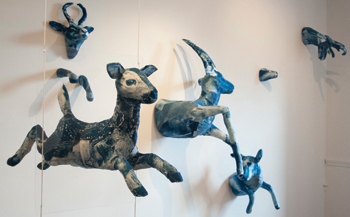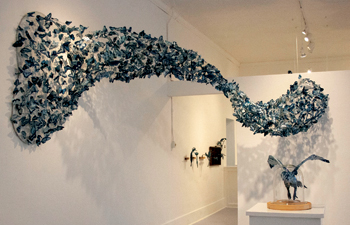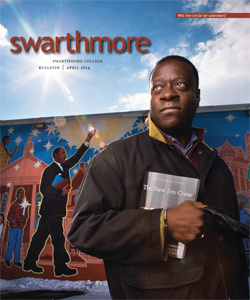Evolving the Arts
Artistic expression and academic rigor find a happy marriage on campus

Tasha Lewis ’12 remembers her senior studio as a highlight of her art major. “People at other schools have little closets or they don’t work in the same space,” she says, describing the wide-open fourth floor in Beardsley Hall with divided areas for each senior art major. “If you’re working late at night, and someone’s studio has a light on, you can pop in and say hi. That makes a huge difference.”
The butterflies, and later the antelopes, conspired to break free of Tasha Lewis ’12’s mind and then out of Beardsley Hall. Her antelope sculptures breached walls at Hobbs Coffee in The Ville, then they galloped about in the College’s List Gallery before flocking to Old Tarble. From there, the majestic cyan herd pranced above gallery patrons’ heads in Philadelphia, then Indianapolis, jumping through walls and frolicking with a swarm of blue butterflies, a jaguar, birds, and foxes. Two years later, these fabric-patchwork sculptures continue their whimsical migration for admirers around the country. They’re in so much demand that creator Lewis is able to work full time as an artist. But before their release into the world, Lewis’ first butterfly thoughts found physical form on the fourth floor of Beardsley.
“My initial senior studio idea was to create photographic taxidermy—a representation of natural forms in space,” says Manhattan-based Lewis, now an Artist-in-the-Marketplace Fellow at the Bronx Museum. “I worked out those ideas with professors at Swarthmore, and I’m still working them out.”
Now, imagine Lewis’ serene herd leaping backward: way, way back to the 1950s. Then, Swarthmore was essentially a liberal arts school—without the arts. Some accounts attribute the former dearth of the now–well-ensconced theater, dance, music, and studio arts programs to a Quaker belief that creative endeavors were frivolous. Harriet Shorr ’60, who taught studio art classes on campus throughout the ’60s, once said that Quakers were “suspicious of beauty that was not utilitarian.”
Those presumed opinions aside, student demand for artistic outlets has been keen since the mid-’50s. Begun in the late ’30s, an arts and crafts program on campus grew so popular that in 1954 Barbara Elmore—wife of physics professor William Elmore—was hired as full-time director. She once wrote that she could not see how art history majors could “graduate without ever having tried their hand at painting or sculpture.”
Other arts on campus were similarly marginalized. Music, though a part of the curriculum since the ’20s, did not see its first full-time faculty appointment until 1955 when Peter Gram Swing was hired to teach and make music. During the next decade, music became a formal major on campus, with the department expanding to three full-time professors. While music was the first of the arts to gain departmental status, it struggled to be seen as academically substantive. Course credit for what was called “creative arts,” as opposed to more theory-based arts studies, was a key challenge for all of the arts on campus until 1989.
“When I started, there was a five-credit limit on creative arts across the board: music, dance, theater, and studio art,” says Professor of Studio Arts Randall Exon, who came to Swarthmore in 1982, only five years after now-retired art history professor T. Kaori Kitao blazed the trail for studio arts to become a major. “Students could take more than five credits—and the art students always did—but the classes wouldn’t count toward graduation.”
In 1970, the foundation of the theater department began when the English department dedicated a tenure line to theater and brought in retired theater professor Lee Devin. The classes, which focused mainly on acting, were also considered studio credits.
“Before 1970, Swarthmore was typical of private colleges and universities, especially the Ivy League,” says Allen Kuharski, chair of the theater department. “The model came from Oxford and Cambridge, which, to this day, has no performing arts in the curriculum. The idea of the practice of the performing arts as academically rigorous is, really, an American idea.”
As the music, dance, theater, and studio arts programs blossomed, with classes filling quickly, the cap on creative arts credits increasingly hindered comprehensive study. Finally, in fall 1989, the performing arts classes were freed from the five-credit rule—but not without acrimony.
“There was quite a rancorous debate on the floor of the faculty when we lifted that limit,” says Provost Tom Stephenson, who was then a chemistry professor. “I think having such a restriction put us out of step with American higher education in the late ’80s. Lifting the cap was a recognition that artistic expression can be a form of academic rigor.”
The move kicked off a new artistic era for the College, one that’s ongoing. In 1988, theater became a major, and in 1991 the program moved into the new Lang Performing Arts Center (LPAC).
“In some ways, LPAC was the physical manifestation of the College’s commitment to the arts,” says Stephenson. “The [Lang] music building, which preceded it, is a fabulous facility, but it’s a little bit tucked away in the woods, while LPAC is very much front and center on campus.”

Tasha Lewis ’12’s butterflies, seen above in Harrison Center for the Arts in Indianapolis, sprang from an idea originally conceived and nurtured on campus. “The art faculty is small, which greatly benefits students—everyone is excited to look at what you’re doing and provide feedback. I even reached out to the art history faculty, and they were happy to stop by my studio. That was great.”
Though music, dance, theater, and studio arts attract more student practitioners than ever, nonmajors account for much of the participation. For instance, of the 60 or so members of the College orchestra, only about six are majors, says Thomas Whitman ’82, associate professor of music.
But lack of majors does not mean lack of talent.
“We attract many more talented and highly motivated musicians because they can get academic credit for performance. This has raised our profile,” says Whitman, comparing the music department to when he was a student. “Some students come because they are interested in majoring, knowing they can get a solid music education here. Others have decided that, while they’re not going to major in music, they’d like to continue lessons as a part of being a well-rounded college student.”
Exon—who estimates his department graduates about 12 majors each year from the College’s overflowing studio art classes—finds that nonmajors and double majors contribute to the diversity that is the hallmark of liberal arts schools.
“Students bring their own disparate disciplines to bear on what they do as an artist, which is terrific,” he says. “There are certain students who use the College almost like a big computer, and they know how to work it and blend their studies in a seemingly magical way.”
Sharon Friedler, professor and director of the dance program since 1985, says that about 16 percent of the student body—approximately 250—enroll in dance classes every semester. Founding director Patricia Wityk Boyer, who arrived in 1968 when dance was still a part of phys ed, collaborated with Jim Freeman, Daniel Underhill Professor Emeritus of Music, so much, that in 1977 it seemed natural to embed the dance program within the music department. Current dance offerings—which now include more than 35 different classes in technique, composition, history, theory, and repertory—are strongly guided by Swarthmore’s principles.
“We contribute to the College mission through offering a variety of global perspectives in composition, history, repertory, technique, and theory classes, and we realize [the mission] through social change,” says Friedler, who cites the program’s synchronicity with study- abroad opportunities and Fulbright, Luce, and Watson fellowships. “By engaging reality through an embodied experience in techniques and styles of movement from around the world, you begin to build an understanding of others as well as yourself. That’s the sort of implicit added bonus to dance education.”
Kuharski explains that, where theater is concerned, there are still plenty of skeptics. “There is a resistance within the academy to what we do. That’s why I’ve tried to build not only a rigorous program but one that fosters both love and respect,” he says, noting that the majority of the six to eight theater majors each year are also in the honors program. “It’s easy to love theater, but to garner respect, I tell majors that we all need to work hard and be fully deserving of what Swarthmore provides.”
Meanwhile, working artist Lewis’ menagerie has continued to roam, stopping now to gambol through the commons of LaGuardia Community College in Queens. The sculptures, which draw fascinated and inspired onlookers daily, are the offspring of Swarthmore.
“The senior studio was the melting pot for the work I’m doing now,” she says. “I feel like I’m still on a roll from the momentum I built up at Swarthmore, and I’m just trailing that out.”
Watch NYU Tisch School of the Arts Dean Mary Schmidt Campbell ’69 discuss her take on the role of the arts in the liberal arts here.
See Lewis’ butterflies on campus here.
 Email This Page
Email This Page